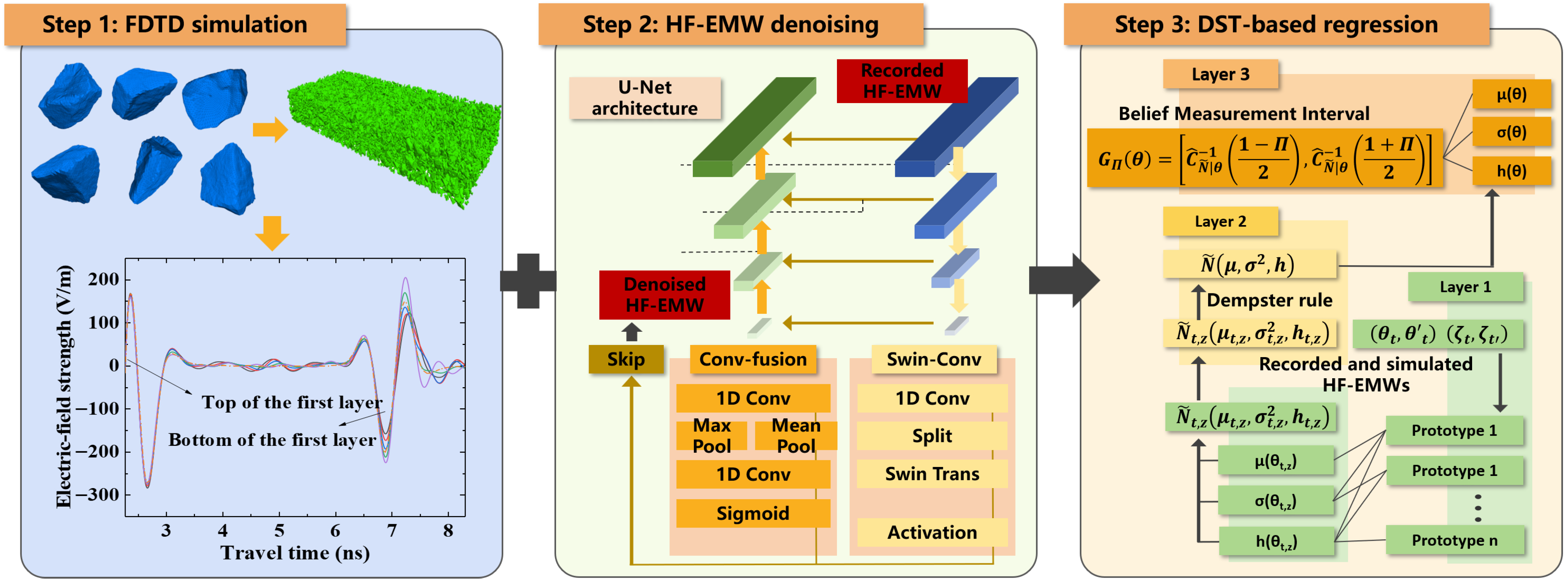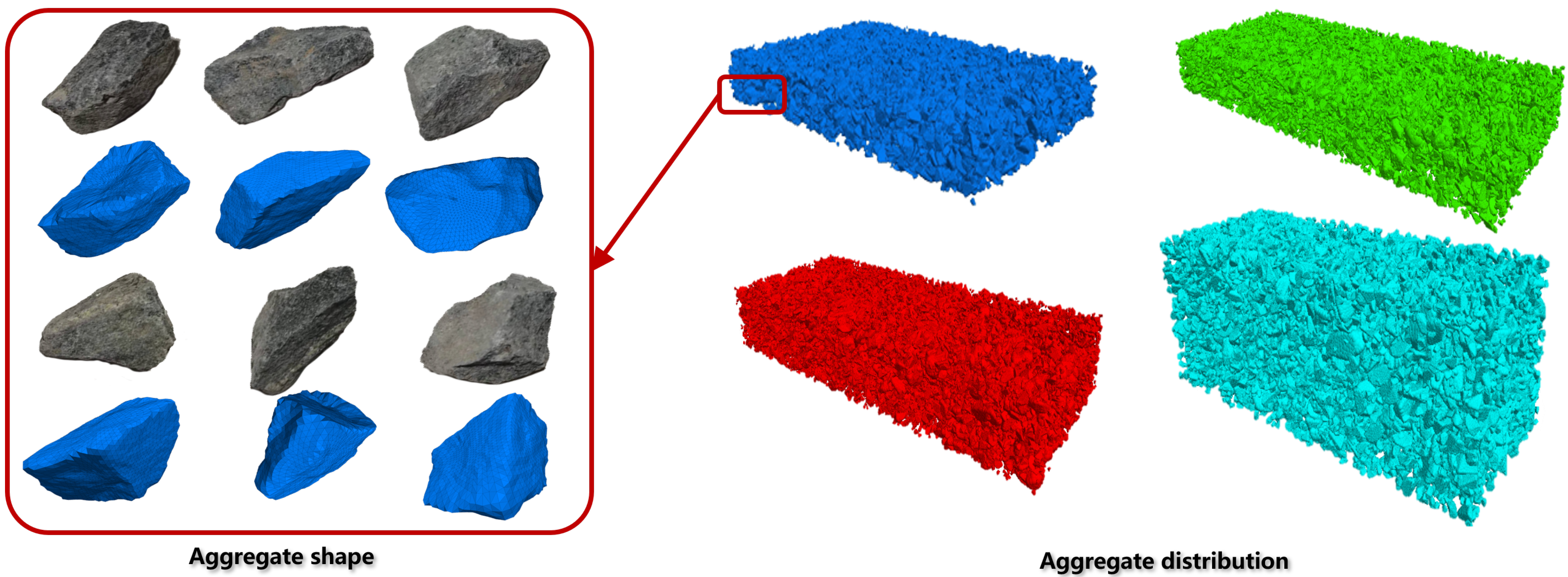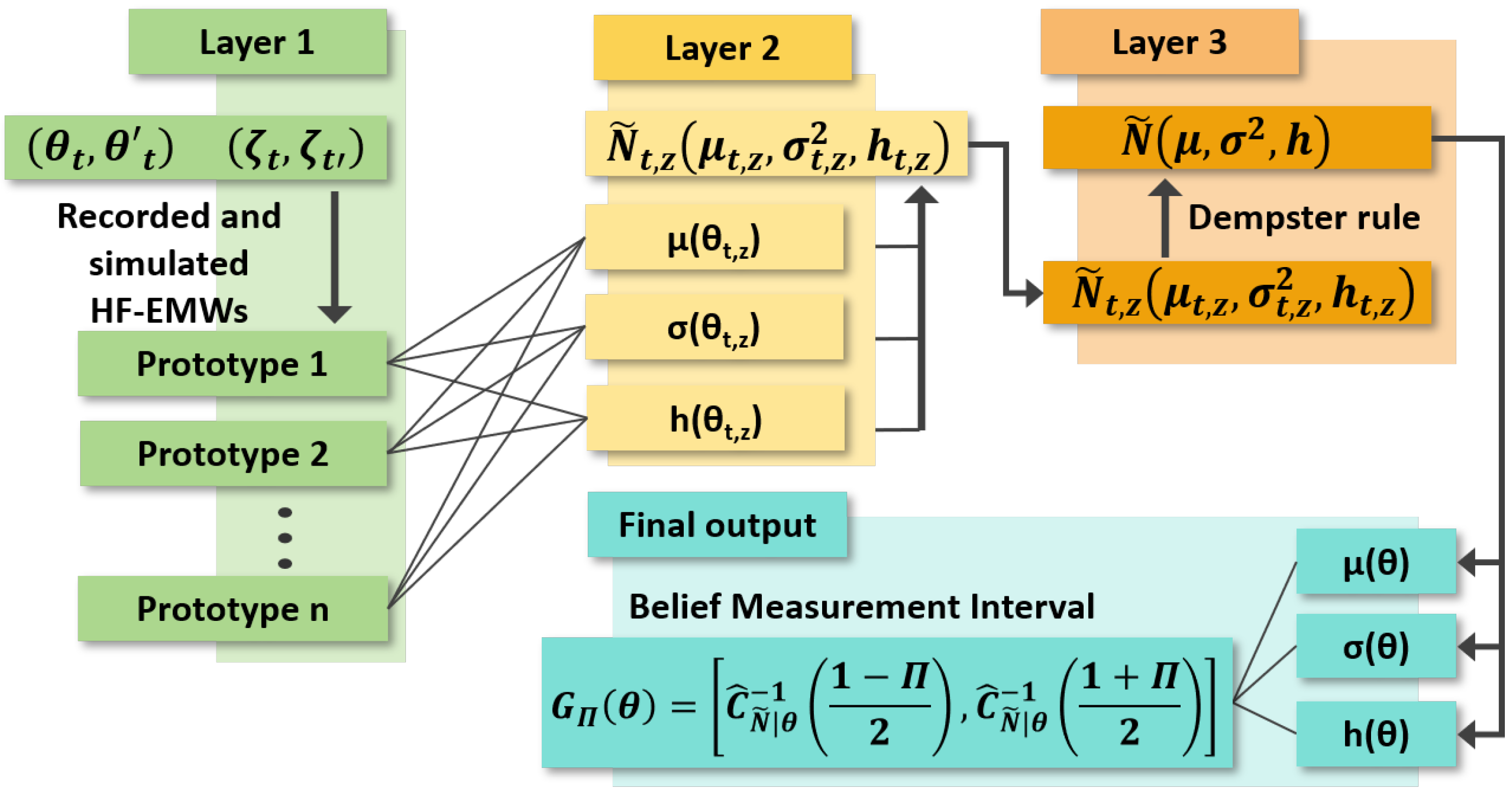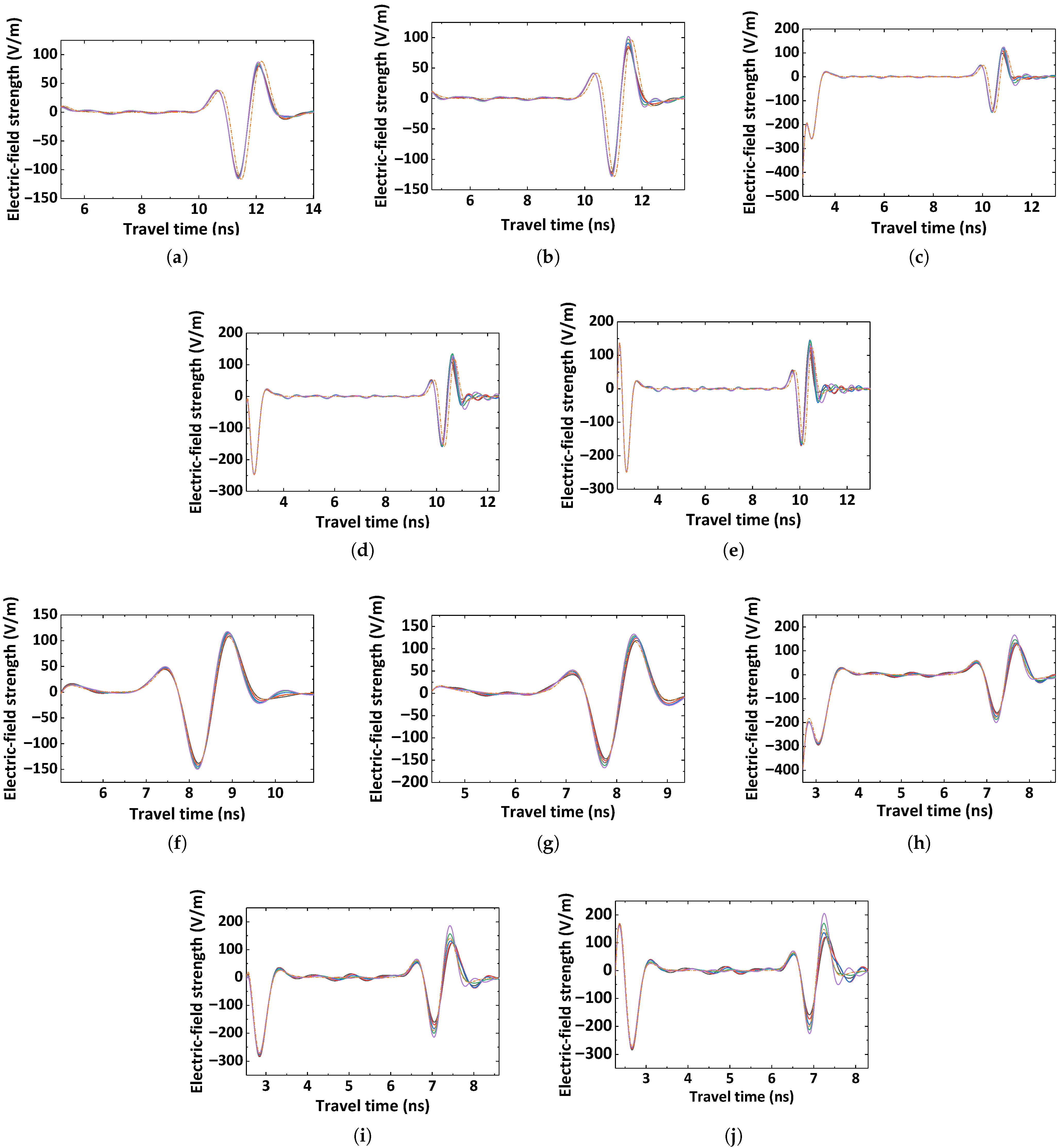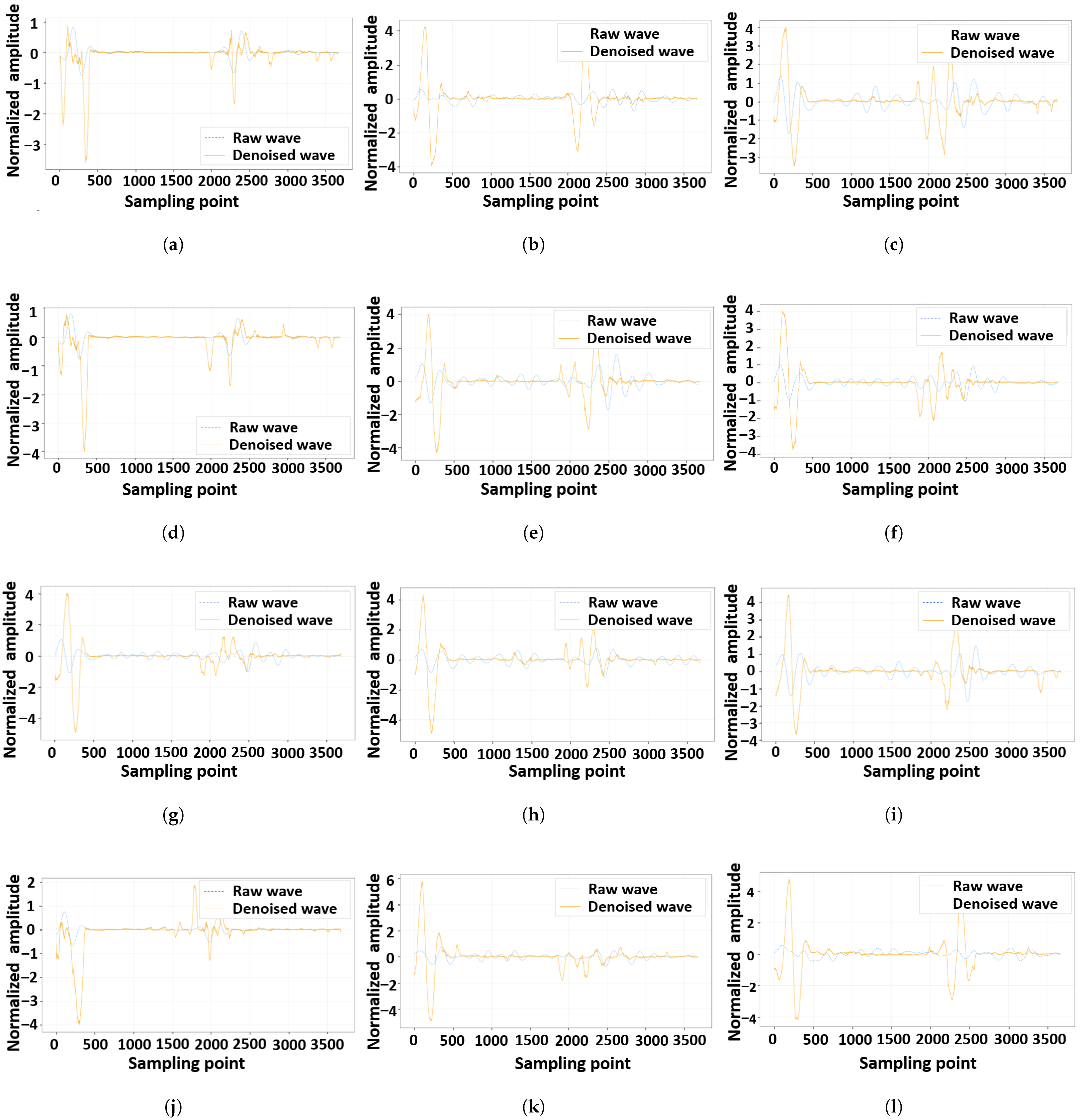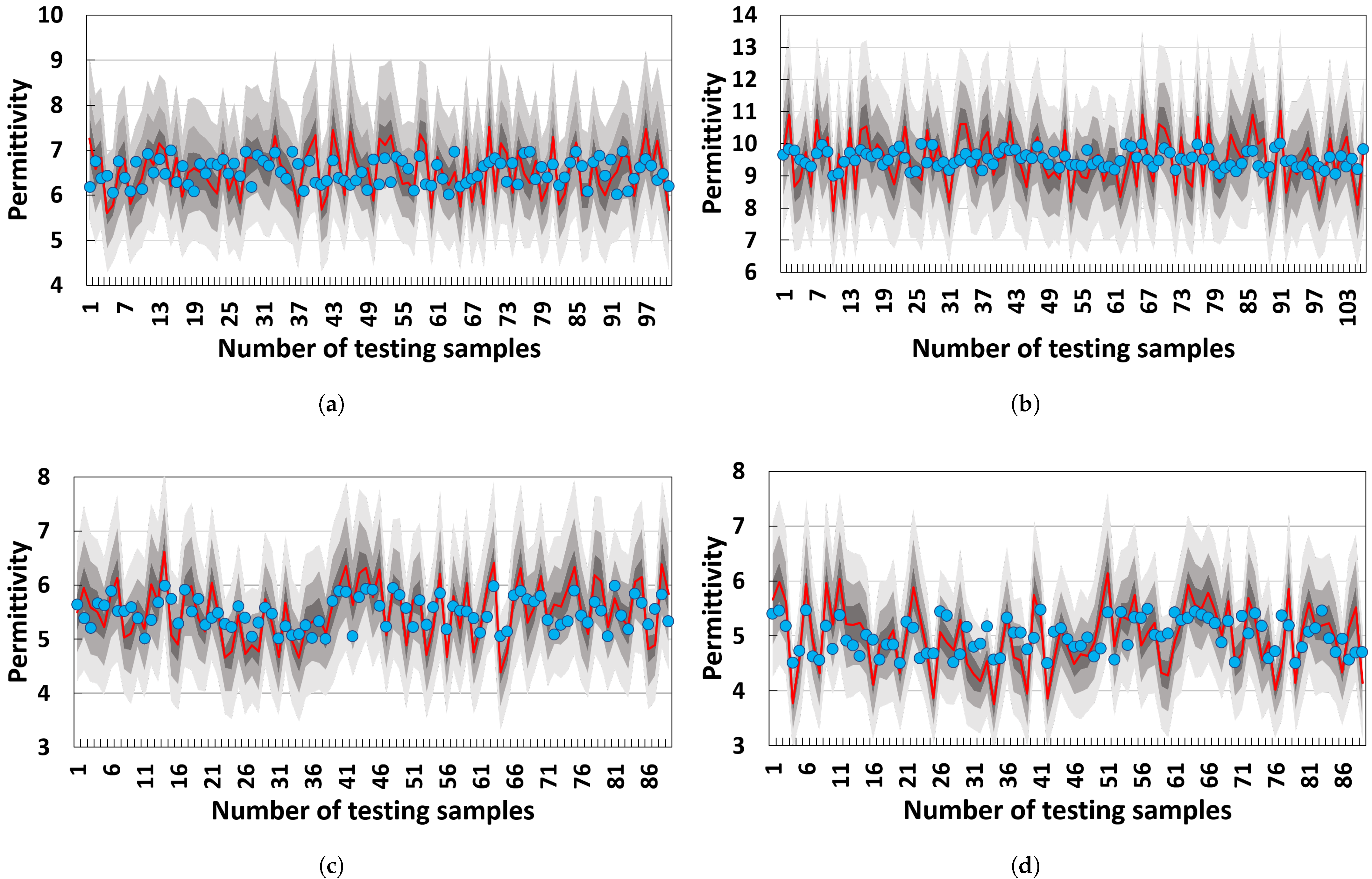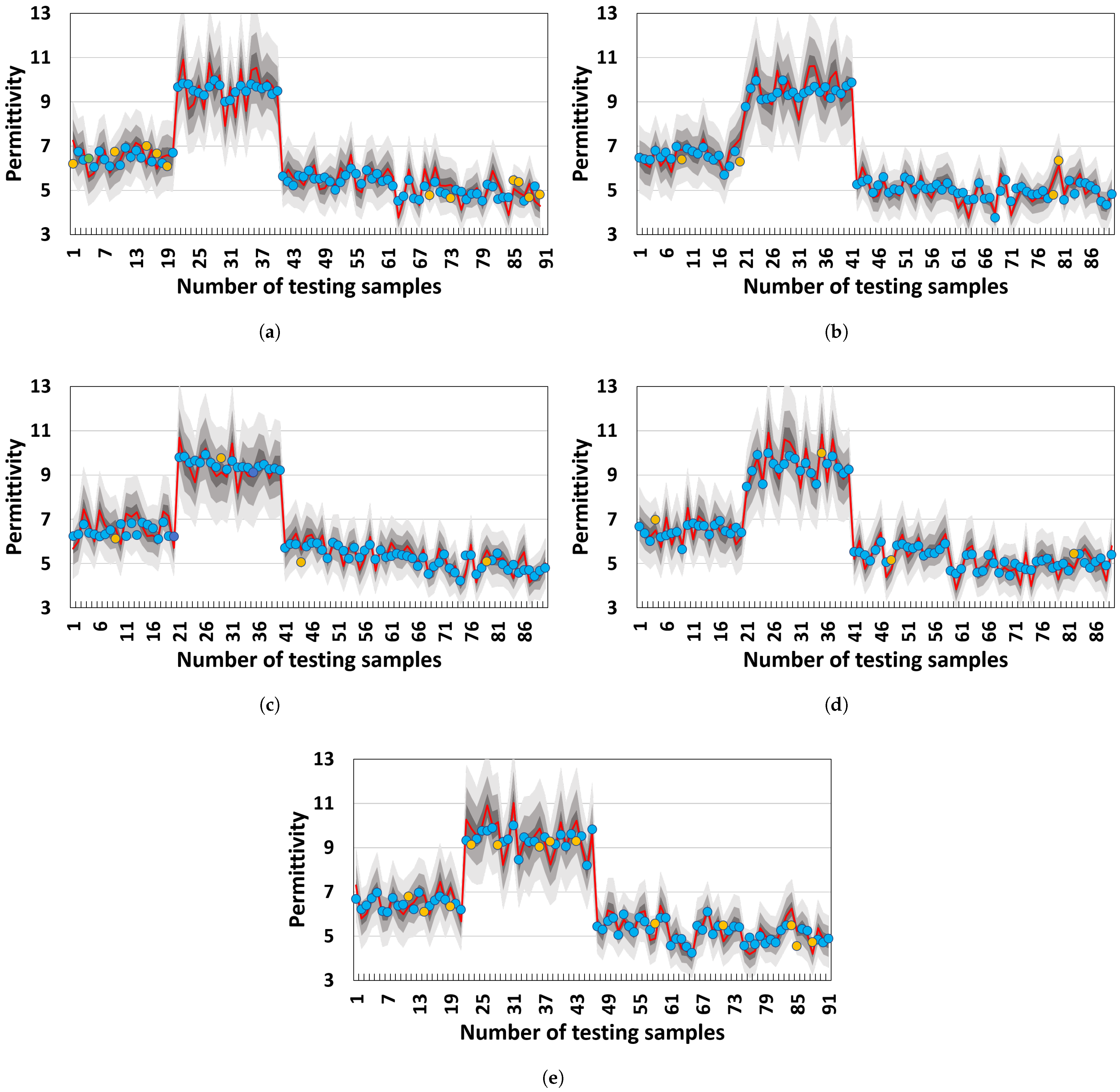3.2. Finite-Difference Time-Domain Simulations for Multi-Phase Concrete
3.2.1. Component Distribution Simulation Using Discrete Element Method
The finite-difference time-domain (FDTD) method was employed to simulate HF-EMW propagation within a concrete sample. The simulation is conducted using GPRMax v.3.1.5, an open-source software widely used for modeling electromagnetic wave propagation. However, GPRMax’s default geometry commands only allow the construction of basic shapes such as rectangular blocks, spheres, and cylinders, limiting its ability to represent the irregular geometries of real-world pavement materials, such as coarse aggregates and cement mortar. As a result, simulations often rely on layered homogeneous models to approximate heterogeneous media, which introduces significant discrepancies between the simulation outputs and actual HF-EMWs.
To address this limitation, this study incorporates a discrete element modeling (DEM) approach, which is well-established in material mechanics for simulating complex micro-structures. Specifically, this method approximates the surface contours of arbitrarily shaped materials by randomly distributing spherical particles of varying sizes. The resulting geometric models enable accurate reconstruction of the true morphology and volume fractions of different material phases within concrete samples.
The modeling workflow begins with finite element software to construct detailed material structure models, which are then imported into GPRMax for HF-EMW propagation simulation. Compared with conventional homogeneous models, these reconstructed heterogeneous models offer significantly improved realism in capturing radar wave behavior. The PFC3D software is used to reconstruct the material distribution within concrete samples.
Real aggregate particles are first scanned using multi-view laser scanning technology to obtain dense point cloud coordinate data. Spherical fitting is then applied to approximate the surface geometry of the aggregates, enabling 3D reconstruction of aggregate phase contours. Six real aggregate particles of different sizes and shapes are selected from high-performance concrete mixtures to serve as representative samples, as shown in
Figure 2. These samples are placed on an automated rotary platform and scanned using a handheld laser scanner to capture their surface geometry from all angles.
The scanned point clouds are imported into Geomagic Studio, where the surface contours of each aggregate are reconstructed. Based on the 3D point cloud data, a contour-sphere approximation method is applied. Using the Bubble Pack algorithm, multiple spheres of different radii are generated to fill the internal volume of each aggregate within the point cloud coordinate system. This process allows the geometric approximation of complex aggregate shapes and the construction of a library of 3D particle models.
The aggregates are then randomly distributed in the 3D space according to target gradation curves, forming multi-phase heterogeneous concrete samples. The samples have a size of 1.5 m × 1.5 m. The mass proportions of aggregates with different sizes are shown in
Table 2.
The generated aggregate particle models were imported into PFC3D as clump templates, representing six distinct aggregate types. These clump templates were then randomly deployed within the discrete element model according to a graded distribution scheme. The placement followed a descending size order, aligning with the target gradation curve: Larger particles were placed first to form a skeletal framework, while smaller particles were subsequently filled into the voids between the larger aggregates, thereby creating a hierarchical, well-graded packing structure. For fine aggregates with particle sizes ranging from 0.6 mm to 4.75 mm, spherical particle models available in PFC3D were used due to their relatively small volume. After the skeleton and fine aggregates were placed, a vertical compressive load was applied to the model to simulate compaction and achieve a dense packing configuration. Four samples of different concrete materials are shown in
Figure 2.
3.2.2. FDTD Simulation
The electromagnetic simulation is performed using the GPRMax software. To incorporate the discrete element model generated by PFC3D into GPRMax, the latter’s built-in functionality is utilized to convert image data into the HDF5 format required by its electromagnetic FDTD solver. Specifically, the 3D discrete element model of the concrete sample is reconstructed, and random cross-sectional images of the heterogeneous material distribution were generated. After preprocessing, the spatial distribution and morphology information from these images were converted into HDF5 files. These files were then imported into GPRMax, where the permittivities of all component phases are defined, enabling the simulation of electromagnetic field components of HF-EMW propagating through the multi-phase heterogeneous sample. The detailed settings for the electromagnetic FDTD model in GPRMax included the sample, electromagnetic parameters, grid resolution, model dimensions, and scan duration, as described as follows.
Model Sizes: The size of the multi-phase heterogeneous sample is 1.5 m × 1.5 m × D, where D denotes the thickness of 0.08 m, 0.05 m, 0.08 m, and 0.05 m for Materials 1, 2, 3, and 4, respectively. Vertically, each multi-phase heterogeneous sample also consists of a 0.01 m thick air layer.
Air-Layer Configuration: The air layer provides space to position the antenna, maintaining a vertical separation of 0.15 m between the antenna’s center and a sample’s surface. This setup replicates the actual measurement conditions of air-coupled GPR systems. It effectively suppresses the direct ground wave interference on interface reflections from the top surface of the cement panel, thereby enhancing the distinguishability of the target reflected signals. The bottom air layer serves to eliminate boundary reflection artifacts that could otherwise interfere with the integrity and accuracy of reflection signals from the lower interface of the concrete samples.
Antenna Frequency, Time Window, and Other Parameters: Considering the propagation characteristics of electromagnetic waves in heterogeneous materials, as well as the trade-offs among signal resolution, penetration depth, and antenna frequency, other parameters of the electromagnetic finite-difference model were selected based on industry empirical values. These parameters are summarized in
Table 3.
Permittivity Settings: In the model construction, void (air gap) regions are assigned around a concrete sample. By adjusting the permittivity values, different filling media conditions inside the voids can be simulated. When the void is completely dry, it is filled with air, with a relative dielectric constant of 1.00. Conversely, when fully saturated, the void is filled with water, for which its relative dielectric constant is 81.00.
For multi-phase heterogeneous media, basalt is selected as the aggregate material for particle sizes in the millimeter range, with its permittivity set to 8.00. Considering the frequency-dispersive nature of cement concrete, the permittivity of the composite phase “aggregate (mm)-cement mortar-pore” is computed as
where
is the effective dielectric constant of the composite phase;
,
, and
are the dielectric constants of the aggregate, mortar, and pores, respectively;
,
, and
represent their volume fractions. The aggregate particle size is denoted by the subscript
a.
3.3. Deep Denoising Network
A Unet model is designed to denoise the HF-EMWs with encoder, bottleneck, and decoder modules, as shown in
Figure 3. Compared with other signal denoising architectures, such as LSTM and CNN-RNN hybrids, the U-Net architecture enables efficient feature extraction across multiple temporal scales through its encoder–decoder structure and skip connections. This not only preserves fine-grained waveform details but also facilitates effective noise suppression. Additionally, the incorporation of attention mechanisms and Swin Transformer modules further enhances the U-Net’s ability to capture both local and global signal patterns, making it particularly well-suited for handling the noisy, multi-component characteristics of HF-EMW data. This advantage will be demonstrated in
Section 4.3.
(1) Encoder module.
The encoder of the UNet architecture is designed to progressively extract features from the input one-dimensional signal through a series of downsampling operations, thereby constructing multi-scale feature representations.
The encoder consists of three cascaded downsampling modules, each composed of a residual block, an attention mechanism, and a pooling layer. The encoder takes a preprocessed and augmented input signal of shape (batch_size, 1, signal_length).
In the first downsampling module, the input signal is initially processed by a ResidualBlock1D for feature extraction. This block uses two convolutional layers with batch normalization and a skip connection, which helps alleviate the vanishing gradient problem and retains part of the original signal features. Following this, the AttentionBlock1D applies global average pooling and fully connected layers to generate channel-wise attention weights, enabling the network to enhance important features and suppress irrelevant information during training adaptively. After this stage, the number of channels expands from 1 to base_filters, while the signal length remains unchanged.
The two downsampling modules follow a similar structure but include max-pooling layers for temporal downsampling. Each pooling operation reduces the signal length by half, and the channel dimension is doubled through convolution. Specifically, the second module increases the channel dimension to base_filters × 2, and the third module further increases it to base_filters × 4, while the signal length is reduced to one-half and one-quarter of the original.
Because shallow layers use small convolution kernels with limited receptive fields, their feature maps correspond directly to local variations in the waveform, making them more effective in capturing local signal features. In contrast, deeper layers with attention mechanisms focus on low-frequency global features, as the abstracted signal representations in deeper layers are less concerned with fine-grained waveform details and more with statistical distributions. Hence, deeper modules are designed with larger receptive fields to capture the global context.
Through this hierarchical structure, the encoder combines the locality of convolution with multi-scale abstraction, preserving both fine-grained and global features of the signal. After passing through the three cascaded down-sampling modules, the encoder outputs a high-level feature representation of shape (batch_size, base_filters × 8, signal_length/8).
(2) Swin Transformer
Traditional CNNs rely solely on local receptive fields, which limits their ability to capture long-range dependencies in sequential signals. The introduction of a bottleneck layer addresses this issue. Specifically, the bottleneck receives the final output from the encoder, which has a shape of (batch_size, base_filters × 8, signal_length/8).
To adapt this high-level feature tensor for processing by the Swin Transformer, it is first reshaped into a two-dimensional feature map of size . The transformed feature representation is then fed into a Swin Transformer module. The Swin Transformer employs a window-based self-attention mechanism, enabling the model to capture cross-window dependencies and integrate the global contextual information of the signal effectively. After processing through the Swin Transformer, the output retains the same shape as the input to the bottleneck layer, i.e., (batch_size, base_filters × 8, signal_length/8).
(3) Decoder
The decoder mirrors the structure of the encoder and constitutes the right half of the U-shaped UNet architecture. It progressively restores the signal details through transposed convolutions (deconvolutions), skip connections, and feature fusion.
The decoder takes as input the high-level feature representation from the bottleneck layer, with a shape of [B, base_filters × 8, signal_length/8]. It then employs three upsampling modules to gradually reconstruct the feature map back to the original signal length. Each upsampling module consists of a transposed convolution layer, a feature concatenation operation, and a residual-attention block.
Transposed convolution, essentially a convolution operation in reverse, inserts zero-padding between elements of the input feature map and applies a convolution kernel to enlarge the feature map, restoring it to the spatial dimensions consistent with the corresponding encoder layer. The upsampled features are then concatenated with the output from the x-th encoder layer along the channel dimension, resulting in a composite feature map with doubled information. A subsequent convolution compresses the number of channels back to base_filters × 4 (e.g., 256), followed by a residual block and an attention block to integrate the features and refine both the spatial and channel dimensions.
After passing through all three upsampling stages, a final layer with a convolution maps the output to a single channel, yielding a denoised signal with dimensions [B, 1, L], matching the shape of the original input.

